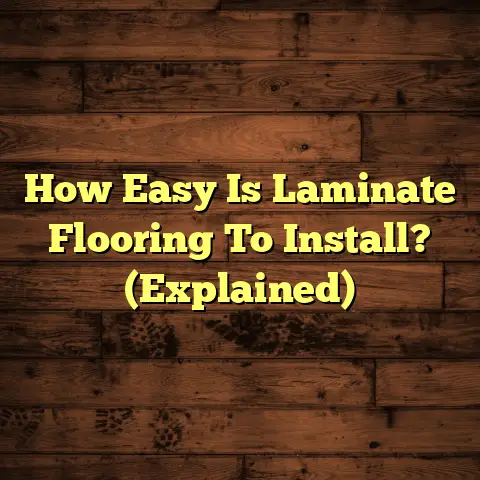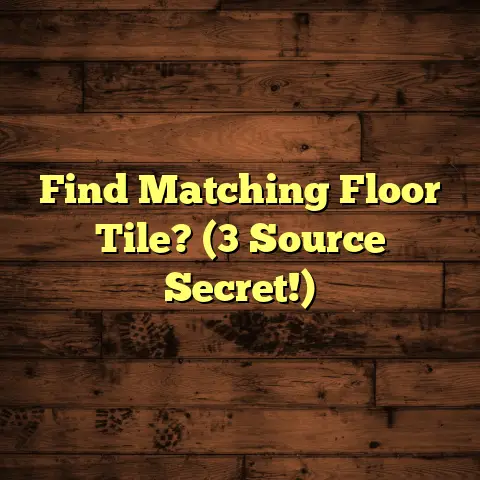Concrete Floors: Which Type is Best? (3 Top Picks!)
Imagine walking into a home where every step on the floor feels both sturdy and luxurious, with a cool, polished surface underfoot that exudes modern elegance.
You notice how the natural light dances across the floor, highlighting its unique textures and colors.
As you explore further, you realize that the flooring isn’t just aesthetically pleasing; it also withstands the test of time, requiring minimal maintenance while offering an impressive range of design options.
What if you could create this ideal environment in your own home?
In this article, I’ll dive deep into the world of concrete floors.
I’ll explore various types and ultimately reveal my three top picks for the best concrete flooring options available today.
Let’s get started, shall we?
Section 1: Understanding Concrete Flooring
Concrete flooring isn’t just for basements or garages anymore!
It’s a versatile material made from a mixture of cement, water, and aggregates like sand and gravel.
What makes it unique? Its incredible durability, thermal mass (meaning it can help regulate temperature), and the potential for endless customization.
Think about it: you can stain it, polish it, stamp it, and even engrave it.
Concrete thrives in diverse environments.
In residential spaces, it brings a modern, minimalist vibe.
Commercial settings benefit from its durability and ease of cleaning.
And in industrial environments, it stands up to heavy traffic and machinery.
I’ve seen concrete transform everything from sleek city lofts to bustling retail stores.
The growing popularity of concrete flooring is undeniable.
According to a report by Grand View Research, the global concrete floor coatings market is expected to reach $1.48 billion by 2025.
This surge is driven by the demand for sustainable and aesthetically pleasing flooring solutions.
People are realizing that concrete isn’t just a practical choice; it’s a design statement.
Section 2: Types of Concrete Floors
Let’s explore the main types of concrete floors you’ll encounter.
2.1 Polished Concrete
Polished concrete is achieved through a mechanical process of grinding, honing, and polishing the concrete surface with progressively finer diamond-impregnated tools.
The result? A smooth, glossy finish that’s both beautiful and incredibly durable.
- Durability: Polished concrete is highly resistant to wear and tear. I’ve seen it last for decades in high-traffic areas with minimal maintenance.
- Ease of Maintenance: A simple sweep and occasional mopping are usually all it takes to keep it looking its best.
- Aesthetic Appeal: The high-gloss finish reflects light, brightening up spaces and creating a clean, modern look.
Finish options range from matte to high-gloss, and you can even expose the aggregate (the stones within the concrete) for a more textured look.
Color choices are virtually limitless, thanks to dyes and stains that can be added during the polishing process.
Ideal applications for polished concrete include:
- Residential living areas
- Retail stores
- Offices
- Warehouses
I once worked on a project where we transformed an old, cracked warehouse floor into a stunning polished concrete surface.
The client was amazed at the difference!
2.2 Stained Concrete
Stained concrete involves applying a stain to the concrete surface to create a permanent color change.
There are two main types of stains:
- Acid-Based Stains: These react chemically with the concrete, creating a mottled, variegated look. They penetrate deeply and produce permanent color.
- Water-Based Stains: These are more environmentally friendly and offer a wider range of colors. They don’t react chemically but rather deposit pigments on the surface.
The range of color options is vast, from earthy tones to vibrant hues.
Staining can enhance the look of a space by adding depth, character, and a unique, custom feel.
Potential uses for stained concrete include:
- Patios and walkways
- Kitchens and bathrooms
- Basements
- Entryways
I’ve used stained concrete to create stunning outdoor patios that seamlessly blend with the surrounding landscape.
It’s a fantastic way to add a touch of elegance to any space.
2.3 Decorative Concrete (Stamped and Engraved)
Decorative concrete takes things a step further, adding texture and patterns to the concrete surface.
- Stamped Concrete: This involves pressing molds into freshly poured concrete to create patterns that mimic brick, stone, tile, or even wood.
- Engraved Concrete: This involves using specialized tools to cut designs into existing concrete surfaces.
The artistic possibilities are endless!
You can create intricate patterns, realistic textures, and custom designs that reflect your personal style.
Decorative concrete is suitable for:
- Driveways and sidewalks
- Pool decks
- Interior floors
- Vertical surfaces (like walls)
I once designed a driveway using stamped concrete that looked exactly like cobblestone.
It added so much curb appeal to the home!
Section 3: Evaluating the Best Concrete Flooring Options
How do we determine which type of concrete flooring is the best?
Let’s establish some criteria:
- Durability: How well does it withstand wear and tear?
- Cost: What’s the initial investment and long-term expenses?
- Maintenance: How much effort is required to keep it looking good?
- Aesthetics: How visually appealing is it?
- Installation Process: How complex and time-consuming is the installation?
Now, let’s get to my top picks!
3.1 Top Pick: Polished Concrete
Polished concrete stands out as the top choice for several reasons.
Its exceptional durability makes it ideal for high-traffic areas.
The low maintenance requirements save you time and money in the long run.
And the sleek, modern aesthetic is hard to beat.
Think about it: you’re getting a floor that looks fantastic, lasts for years, and requires minimal upkeep.
Benefits of Polished Concrete:
- Longevity: Can last for decades with proper care.
- Cost-Effective: Lower long-term maintenance costs compared to other flooring options.
- Eco-Friendly: Uses existing concrete slab, reducing the need for new materials.
- Versatile: Can be customized with various colors, finishes, and aggregate exposure.
Ideal Use Cases:
- Modern homes
- Retail spaces
- Offices
- Warehouses
I’ve seen polished concrete transform dull, industrial spaces into stylish, inviting environments.
It’s a game-changer!
3.2 Second Pick: Stained Concrete
Stained concrete is a strong contender due to its versatility and aesthetic flexibility.
It allows you to create unique, custom looks that reflect your personal style.
Plus, it’s more affordable than polished concrete, making it a great option for budget-conscious homeowners.
Benefits of Stained Concrete:
- Customizable: Wide range of colors and effects to choose from.
- Affordable: Lower initial cost compared to polished concrete.
- Unique: Creates a one-of-a-kind look with variations in color and texture.
- Durable: Resistant to fading and chipping.
Ideal Use Cases:
- Patios and walkways
- Kitchens and bathrooms
- Basements
- Entryways
I often recommend stained concrete to clients who want a unique, artistic look without breaking the bank.
It’s a fantastic way to add personality to any space.
3.3 Third Pick: Decorative Concrete
Decorative concrete is an appealing option for those seeking a personalized touch in their flooring.
Whether you choose stamped or engraved concrete, you can create patterns and textures that truly stand out.
It’s a great way to add curb appeal to your home or create a unique interior design.
Benefits of Decorative Concrete:
- Highly Customizable: Endless possibilities for patterns, textures, and colors.
- Adds Value: Enhances the aesthetic appeal of your home or business.
- Durable: Can withstand heavy traffic and harsh weather conditions.
- Unique: Creates a distinctive look that sets your space apart.
Ideal Use Cases:
- Driveways and sidewalks
- Pool decks
- Interior floors
- Vertical surfaces (like walls)
I once used stamped concrete to create a stunning pool deck that looked like natural stone.
It completely transformed the backyard and added so much value to the home.
Section 4: Costs and Maintenance of Concrete Floors
Let’s talk about the costs and maintenance associated with each type of concrete flooring.
| Flooring Type | Initial Cost (per sq ft) | Long-Term Maintenance | Lifespan |
|---|---|---|---|
| Polished Concrete | $3 – $12 | Low | 50+ years |
| Stained Concrete | $2 – $8 | Medium | 25-50 years |
| Decorative Concrete | $8 – $18 | Medium to High | 20-30 years |
Polished Concrete:
- Cost: The initial investment can be higher, but the long-term benefits outweigh the costs.
- Maintenance: Requires minimal maintenance – regular sweeping and occasional mopping.
- Lifespan: Can last for decades with proper care.
Stained Concrete:
- Cost: More affordable than polished concrete.
- Maintenance: Requires periodic resealing to protect the color.
- Lifespan: Can last for 25-50 years with proper care.
Decorative Concrete:
- Cost: Can be more expensive due to the intricate designs and patterns.
- Maintenance: Requires regular cleaning and resealing to maintain its appearance.
- Lifespan: Can last for 20-30 years with proper care.
Factors that can influence longevity include:
- Traffic levels
- Environmental conditions
- Quality of installation
- Regular maintenance
I always advise my clients to invest in professional installation and proper maintenance to maximize the lifespan of their concrete floors.
Section 5: Conclusion: Making the Right Choice for Your Space
We’ve covered a lot of ground in this article.
Let’s summarize the key points:
- Polished Concrete: Durable, low-maintenance, and aesthetically pleasing.
- Stained Concrete: Versatile, affordable, and customizable.
- Decorative Concrete: Unique, artistic, and adds value to your home.
When choosing the right concrete floor for your space, consider your individual needs, preferences, and budget.
Think about the specific applications of the flooring – will it be in a high-traffic area? Will it be exposed to harsh weather conditions?
The right concrete floor can transform a space, combining functionality with cutting-edge style.
Whether you choose polished, stained, or decorative concrete, you’re making a smart investment in your home or business.
I hope this article has helped you make an informed decision.
Good luck with your flooring project!





